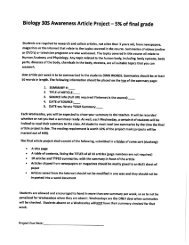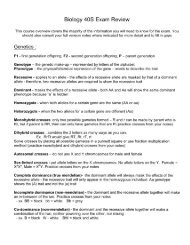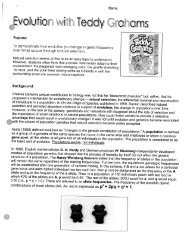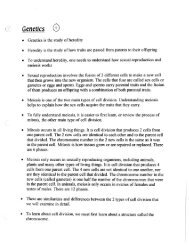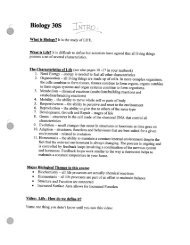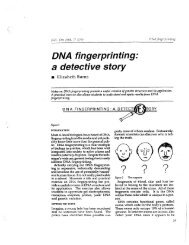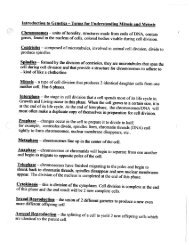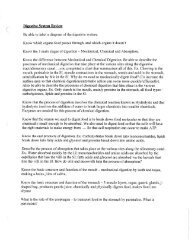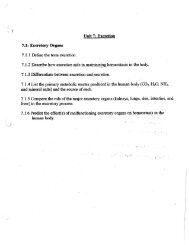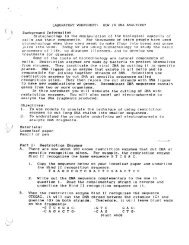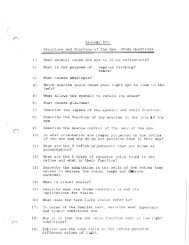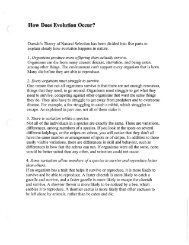The Roles of the Nephron of the 120 ml of blood that is ... - Mrs Stovel
The Roles of the Nephron of the 120 ml of blood that is ... - Mrs Stovel
The Roles of the Nephron of the 120 ml of blood that is ... - Mrs Stovel
- No tags were found...
Create successful ePaper yourself
Turn your PDF publications into a flip-book with our unique Google optimized e-Paper software.
capsule. Bowman's capsule acts to "filter" or separate some <strong>of</strong> <strong>the</strong>substances <strong>that</strong> are located in <strong>blood</strong> plasma from o<strong>the</strong>rs. Th<strong>is</strong> <strong>is</strong> becausesome substances are small enough to fit through <strong>the</strong> pores <strong>of</strong> <strong>the</strong> membrane<strong>of</strong> Bowman's capsule and some are too large and thus do not enterBowman's capsule with <strong>the</strong> rest <strong>of</strong> <strong>the</strong> <strong>blood</strong> plasma. Water, salt ions(sodium, potassium and choride), glucose molecules, amino acids and ureamolecules are all small enough to go through <strong>the</strong> membrane pores intoBowman's capsule. Blood cells (rbc, wbc and platelets) and proteins on <strong>the</strong>o<strong>the</strong>r hand are too large to leave <strong>the</strong> capillaries or enter Bowman's capsule.<strong>The</strong> fluid inside <strong>of</strong> Bowman's capsule gets a name change; it <strong>is</strong> now called"filtrate" because it <strong>is</strong> <strong>blood</strong> plasma <strong>that</strong> has been filtered, Th<strong>is</strong> filtrate <strong>is</strong>identical to <strong>blood</strong> plasma minus <strong>the</strong> <strong>blood</strong> cells and proteins. Filtrate <strong>is</strong> saidto be <strong>is</strong>otonic to <strong>blood</strong> plasma with respect to its concentration <strong>of</strong> water, saltions, glucose, amino acids and urea. <strong>The</strong> filtrate will <strong>the</strong>n proceed fromBowman's capsule through <strong>the</strong> rest <strong>of</strong> <strong>the</strong> nephron in <strong>the</strong> following order:proximal convoluted tubule, loop <strong>of</strong> henle, d<strong>is</strong>tal convoluted tubule andfinally <strong>the</strong> collecting tubule. From <strong>the</strong> collecting tubule, <strong>the</strong> filtrate will enter<strong>the</strong> pelv<strong>is</strong> <strong>of</strong> <strong>the</strong> kidney and be called urine.2. ReabsorptionUseful materials such as sugars and salt ions are reabsorbed back into <strong>the</strong><strong>blood</strong> stream. That <strong>is</strong>, materials <strong>that</strong> could still be used by <strong>the</strong> body are sentback to <strong>the</strong> <strong>blood</strong>. Reabsorption happens as filtrate passes sequentiallythrough <strong>the</strong> nephron. Materials re-entering <strong>the</strong> <strong>blood</strong> stream do so through<strong>the</strong> capillary network surrounding <strong>the</strong> nephrons. In short, "good" stuff <strong>is</strong> sentfrom <strong>the</strong> nephron back into <strong>the</strong> <strong>blood</strong>.A. Proximal Convoluted Tubule (PCn:As <strong>the</strong> filtrate enters <strong>the</strong> PCT approximately 80% <strong>of</strong> <strong>the</strong> salt ions (sodiumand potassium), glucose and amino acids are ACTIVELYTRANSPORTED out <strong>of</strong> <strong>the</strong> PCT and back into <strong>the</strong> <strong>blood</strong> stream byspecial "pumping" cells located in <strong>the</strong> walls <strong>of</strong> <strong>the</strong> PCT. <strong>The</strong> process <strong>of</strong>active transport requires energy. Energy in <strong>the</strong> form <strong>of</strong> ATP <strong>is</strong> suppliedby <strong>the</strong> numerous mitochondria <strong>that</strong> are embedded in <strong>the</strong> walls <strong>of</strong> <strong>the</strong>PCT. Because <strong>of</strong> ionic attraction, negatively charged chloride ions (CI-)will flow passively out <strong>of</strong> <strong>the</strong> PCT as <strong>the</strong>y are attracted by <strong>the</strong> positivelycharged sodium and potassium ions (Na+, K+). As <strong>the</strong> concentration <strong>of</strong><strong>the</strong> above mentioned solute molecules drops inside <strong>of</strong> <strong>the</strong> PCT, water



